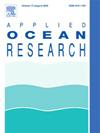Machine learning-based prediction of hydrodynamic forces on small-diameter submarine pipelines: The influence of seabed roughness
IF 4.3
2区 工程技术
Q1 ENGINEERING, OCEAN
引用次数: 0
Abstract
Submarine pipelines are vital components of offshore energy infrastructure, used for transporting oil, gas, and renewable energy resources from sub-sea production sites to processing facilities. The main aim of this study is: first, to investigate the effect of varying seabed roughness and submarine pipeline diameter on the inline and lift wave forces acting on small-diameter pipelines; and second, to propose a quantitative method to determine the wave forces on small-diameter pipelines. Understanding and accurately predicting these hydrodynamic forces is crucial for ensuring the stability and integrity of small-diameter pipelines. To solve this problem, physical model investigations were carried out in a wave flume to assess inline and lift forces on slender pipelines of varying diameters, resting on seabeds with different roughness. The experimental data were used to compute inline and lift force coefficients, which were then utilized to train machine learning models for predictive analysis. It was found that seabed roughness and pipeline diameter significantly influence wave-induced forces. Machine learning (XGBoost) outperforms statistical methods in predictive accuracy but statistical models offer better interpretability for understanding force dynamics. Selecting the optimum quantitative method to determine the wave forces will help in the cost-effective and safe design of small submarine pipelines.
基于机器学习的小直径海底管道水动力预测:海底粗糙度的影响
海底管道是海上能源基础设施的重要组成部分,用于将石油、天然气和可再生能源从海底生产基地输送到加工设施。本研究的主要目的是:首先,研究不同的海底粗糙度和海底管道直径对作用在小直径管道上的直列波力和升力的影响;第二,提出了一种确定小直径管道波浪力的定量方法。了解和准确预测这些水动力对于确保小口径管道的稳定性和完整性至关重要。为了解决这一问题,在波浪水槽中进行了物理模型研究,以评估不同直径的细长管道在不同粗糙度的海床上的线性和升力。实验数据用于计算内联力系数和升力系数,然后用于训练机器学习模型进行预测分析。研究发现,海底粗糙度和管道直径对波浪感应力有显著影响。机器学习(XGBoost)在预测准确性方面优于统计方法,但统计模型在理解力动力学方面提供了更好的可解释性。选择最优的定量方法来确定波浪力,将有助于小型海底管道的经济、安全设计。
本文章由计算机程序翻译,如有差异,请以英文原文为准。
求助全文
约1分钟内获得全文
求助全文
来源期刊

Applied Ocean Research
地学-工程:大洋
CiteScore
8.70
自引率
7.00%
发文量
316
审稿时长
59 days
期刊介绍:
The aim of Applied Ocean Research is to encourage the submission of papers that advance the state of knowledge in a range of topics relevant to ocean engineering.
 求助内容:
求助内容: 应助结果提醒方式:
应助结果提醒方式:


